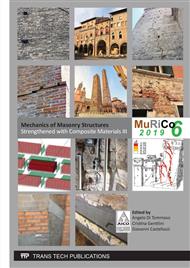[1]
S. Lagomarsino, Seismic assessment of rocking masonry structures, Bulletin of Earthquake Engineering, 13(1): 97-128.
DOI: 10.1007/s10518-014-9609-x
Google Scholar
[2]
F. Ceroni, M. Pecce, S. Voto, G. Manfredi (2009): Historical, architectural and structural assessment of the Bell Tower of Santa Maria del Carmine, Int. J. of Architectural Heritage, Conservation, Analysis, and Restoration, Francis Taylor, 3 (3): 169-194.
DOI: 10.1080/15583050802347490
Google Scholar
[3]
F. Ceroni, R. Cuzzilla, M. Pecce (2016). Assessment of performance of steel and GFRP bars as injected anchors in masonry walls, Construction and Building Materials, 123: 78-98.
DOI: 10.1016/j.conbuildmat.2016.06.124
Google Scholar
[4]
F. Ceroni, A. Prota (2009), Case study: Seismic upgrade of a masonry bell tower by GFRP ties, ASCE, J. of Composite for Construction, 13 (3): 188-197.
DOI: 10.1061/(asce)cc.1943-5614.0000001
Google Scholar
[5]
A. Araújo, D.V. Oliveira, P.B. Lourenço (2014). Numerical study on the performance of improved masonry-to-timber connections in traditional masonry buildings, Engineering Structures 80: 501–513.
DOI: 10.1016/j.engstruct.2014.09.027
Google Scholar
[6]
F. Ceroni., M. Di Ludovico (2008). Traditional and innovative injected anchors in masonry elements: Reliability of existing design formulations, Proc. of 10th International Masonry Conference, G. Milani, A. Taliercio and S. Garrity (eds.).
DOI: 10.1016/j.conbuildmat.2020.119178
Google Scholar
[7]
NIKER (2012). Guidelines for assessment and improvement of connections in buildings, Final Reports D10.2 - New integrated knowledge-based approaches to the protection of cultural heritage from earthquake induced risk, NIKER, Contract FP7-ENV-2009-1, n. 244123.
Google Scholar
[8]
fib Bulletin 58. (2011). Design of anchorages in concrete: guide to good practice, fib, Special Activity Group 4, Fastenings to structural concrete and masonry structures. 978-2-88394-098-7.
Google Scholar
[9]
B. Gigla, F. Wenzel (2000). Design recommendations for injection anchors as supplementary reinforcement of historic masonry, Proc. of 12th International brick/block masonry conference, Madrid, Spain, 25-26 June 2000, 691–706.
DOI: 10.1201/b21889-257
Google Scholar
[10]
F. Arifpovic, M.P. Nielsen (2006). Strength of anchors in masonry. Department of Civil Engineering, Technical University of Denmark, Rapport BYG DTU No. R-134, ISSN 1601-2917, ISBN 87-7877-205-2.
Google Scholar
[11]
Z.M. Wu., S.T. Yang, J.J. Zheng, X.Z. Hu (2010). Analytical solution for the pull-out response of FRP rods embedded in steel tubes filled with cement grout, Mat. and Struct., Rilem 43(5): 597–609.
DOI: 10.1617/s11527-009-9515-x
Google Scholar
[12]
B. Zhang, B. Benmokrane, A. Chennouf, Prediction of tensile capacity of bond anchorage for FRP tendons, ASCE, J. of Composites for Constructions, 4(2): 39-47.
DOI: 10.1061/(asce)1090-0268(2000)4:2(39)
Google Scholar
[13]
F. Silveri, (2010). Ancoraggi iniettati per il rinforzo sismico di edifici storici in muratura, Ph.D thesis, XXV cycle, Università degli Studi di Brescia.
Google Scholar
[14]
MIDAS FEA 2013 v1.1 (2013). Engineering Solution Development and Design, Engineering Consulting Service for Computer modelling, Simulation, Structural analysis, CSPFea.
Google Scholar
[15]
F. Ceroni, M. Di Ludovico, A. Balsamo (2019). Assessment of design formulation for injected anchors in masonry elements, J. of Building Pathology and Rehabilitation, under review.
DOI: 10.1007/s41024-020-0077-1
Google Scholar


